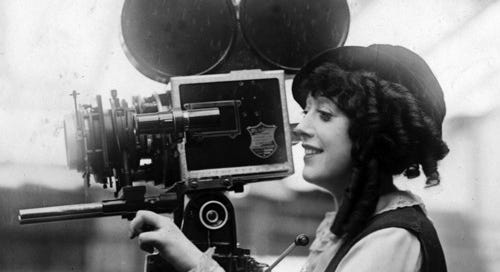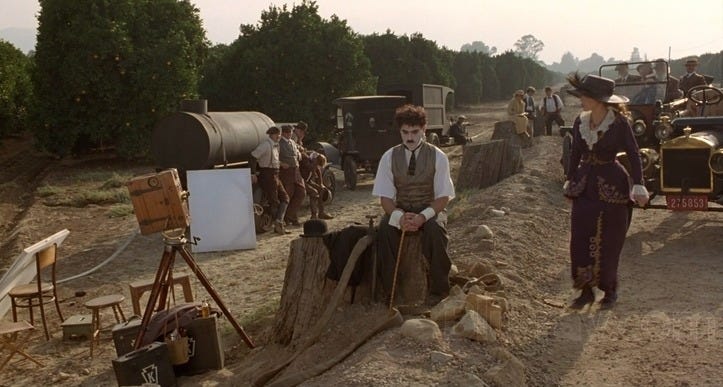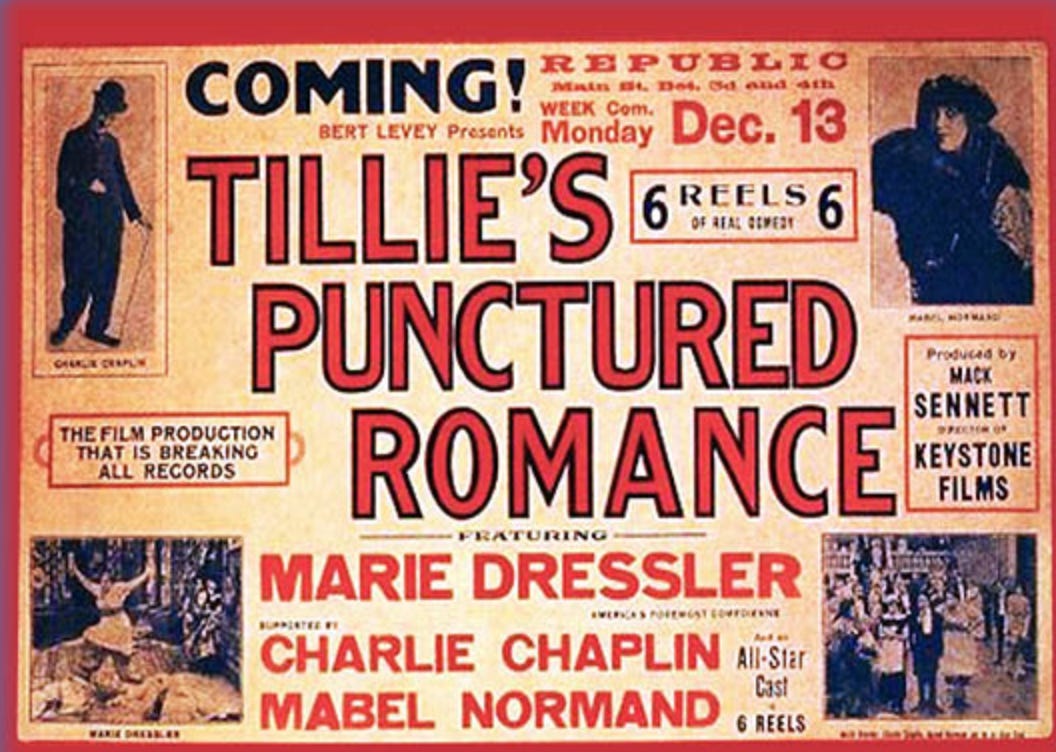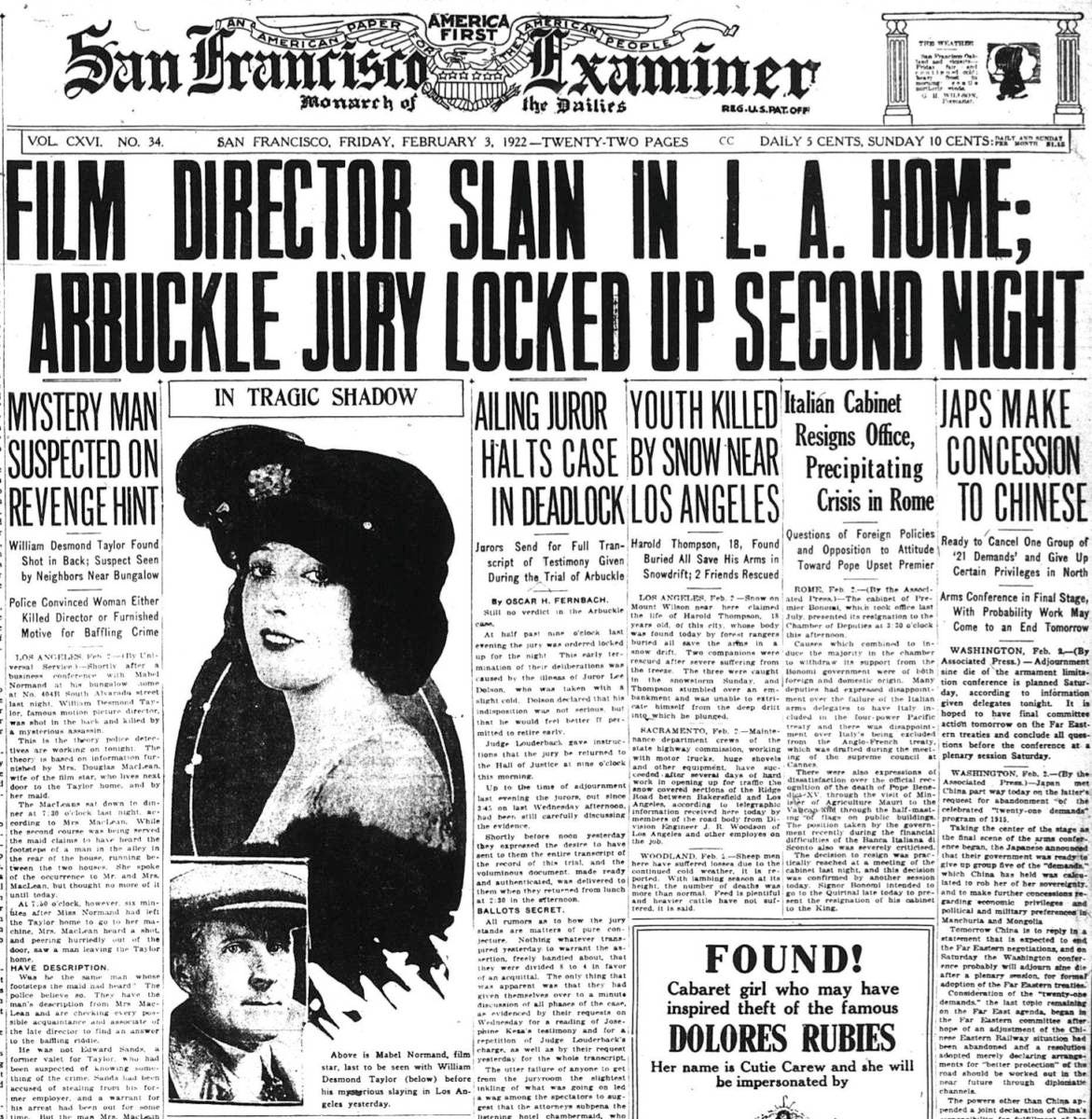This week we are talking about the Queen of Comedy… the one and only Mabel Normand
When I was a teenager, I went to see the movie Chaplin. It may or may not have had something to do with a wee crush on Robert Downey Jr.
There was Mabel Normand, played by Marisa Tomei.
Directing.
My wee future film student heart set alight at the sight of a woman, dressed like Mary Poppins, shouting at the crew and telling them what to do.
The irony is of course, that in the 1992 movie, Dan Ackroyd’s Mack Sennett dismisses Normand’s talents as a director. He says something like “she thinks she can direct” and laughs. If the scene is based on any reality (the main source for the film is Chaplin’s own autobiography, so I’d take it with a shovel of salt), Sennett may have been trying to appease the egocentric nonce to get him to do some work…
In actual reality, Mack Sennett had the utmost respect for Mabel Normand’s filmmaking talent.
He brought her out from New York to help him both establish and run Keystone Studios and his will stated that 50% of everything he had was to be left to her in recognition of her contribution to his empire. Unfortunately she died first, but it’s the thought that counts.
According to Mack Sennett himself, Chaplin’s apprenticeship lasted for “a dozen one- and two-reel pictures,” during which time he “learned [to direct] from Mabel Normand.”
Mabel Normand was, according to producer Hal Roach “the wildest girl in Hollywood,” and, when Roach told her not to swear or talk dirty around young impressionable girls on the lot, she swore more and talked dirtier.
Even once she was a huge star and the undisputed “Queen of Comedy”, she was famous around Los Angeles for being a menace behind the wheel of her lilac limousine. She was also witty, and a voracious reader, devouring book after book on her deathbed in her late thirties (there is a persistent rumour that she died from reasons relating to drug addiction, but she died of TB which had plagued her since childhood). She set out to learn French for no particular reason, she called Mary Pickford a “prissy bitch” in an interview and her favourite food was chocolate cake iced an inch high.
In the early days, writers, directors stars and producers all mucked in and did whatever was needed to get the movie made.
Nowhere was this more true than at Keystone, which — if you remember Universal from a week or two ago, I’ll just say that they didn’t need a zoo for the lot to be chaos. It’s for this reason that no one knows exactly how many movies Normand wrote or directed, other than that it was a lot. What we do know for certain is that she was a leading creative influence at one of the most successful studios in Hollywood.
In 1912, she listed as her profession “director” in the Los Angeles City directory, and in December 1913, Moving Picture World reported that the “leading woman of the Keystone Company, since its inception, is in the future to direct every picture she acts in. This will undoubtedly make Keystone more popular than ever.”
In contrast with Pickford’s dainty wee girl having adventures and Lawrence’s swashbuckling derring-do, Mabel Normand wasn’t afraid to get her hands dirty on screen.
InTillie’s Punctured Romance, Mabel and Marie Dressler, having fought over Chaplin, decide to both dump him (a precursor to Kelly Taylor’s iconic “I choose me”, perhaps?) A contemporary review states that Normand “gives as good as she gets,” and producer Hal Roach, when asked what made Normand funny, replied, “you knew that if a guy kicked her, she’d kick him back.” Critic of the time Julian Johnson adds that she “bulwarked all of the Keystone comedy with her own slender shoulders.”
(Why yes, I do hate that this Youtuber labeled the film Charlie Chaplin when it’s a Marie Dressler or Mabel Normand movie WAY before it’s his 🙄)
In 1917, Normand announced that she was leaving Keystone to make more substantial films. “I wanted better pictures,” she said. “I was getting tired of grinding out short comedies to bolster up programmes in which other stars in other companies, as well as our own, were featured in prestigious films and were paid far more than I was.”
I love how seriously the early female filmmakers took themselves.
A couple of years ago, Jennifer Lawrence wrote an essay about how through the Sony hack she discovered how much less she’d been paid than male co stars, for Lena Dunham's newsletter. It was suggested that female stars don’t negotiate as hard as men do, that they’re just happy to be cast. Lawrence said: “But if I'm honest with myself, I would be lying if I didn't say there was an element of wanting to be liked that influenced my decision to close the deal without a real fight. I didn't want to seem "difficult" or "spoiled." “
But in the teens and twenties, women filmmakers had no such compunctions. Mabel Normand eventually earned $4000/week at a time when most Americans didn’t make that in a year. The very first actor to sign a contract to a studio worth a million dollars was Mary Pickford, and even in the late twenties, after this golden age for women in Hollywood was over, Greta Garbo was famous for going on strike whenever she didn’t think she was getting paid enough. (Which, by the way, worked - she eventually signed a contract to MGM in 1929 that made her the highest paid woman in America.) So it’s interesting, that this so-called innate female quality of not demanding raises or negotiating the best deal possible, was established decades after women started working in the industry.
If anyone has heard of Mabel Normand these days, they probably think of her as a cocaine addict (unsubstantiated, by the way), as the woman who allegedly threw herself from Santa Monica pier having discovered Mack Sennett in bed with another actress, or most famously, as the woman implicated in the murder of her close friend, director William Desmond Taylor in 1922.
As the Women Film Pioneers Project at Columbia University puts it: “scholars would do well to refocus attention on Normand’s distinctive contribution to early cinema and slapstick comedy, as well as the nature of her directorial work for Keystone.”
One theory is that scandal was weaponised against Mabel in the early twenties. In the same way that the media targeted actresses for having been photographed with Weinstein or working with Allen more viciously than they went after Weinstein or Allen, as the investigation into Virginia’s death got underway, the media hounded Mabel because of her long professional association with Arbuckle. Then, just six months later, her friend, director William Desmond Taylor was murdered.
One hundred years later, Taylor’s murder is yet to be solved. A Cast of Killers, by Sidney D Kirkpatrick recounts director King Vidor’s attempts to investigate the Taylor case in the sixties. It is semi fictionalised, and many of the details in A Cast of Killers have been discredited, but it still remains one of the more definitive accounts of the case.
One of the theories it suggests is that Mabel Normand was hung out to dry by the studio as a way of them getting rid of an over-the-hill actress who was on an expensive contract. Mabel had reigned as “Queen of Comedy” for almost a decade at this point, and it’s maybe not unfair to say that as the age of the flapper got underway, her madcap style may have been starting to look a bit dated. But, it’s a bit chicken and egg: she was still making successful movies until she took the hit of the scandals and drug rumours, so were they in response to a career that was slowing down, or were they the brakes?
For what it’s worth, here is a poster for The Extra Girl starring Normand, which came out in 1923: a whole year after Arbuckle’s trials and Taylor’s death.
And when we put on our feminist tin hats and consider that Mabel Normand was not the only powerful woman to have her career all but disappear in a puff of blue smoke in the early twenties... it all becomes a little bit interesting.










